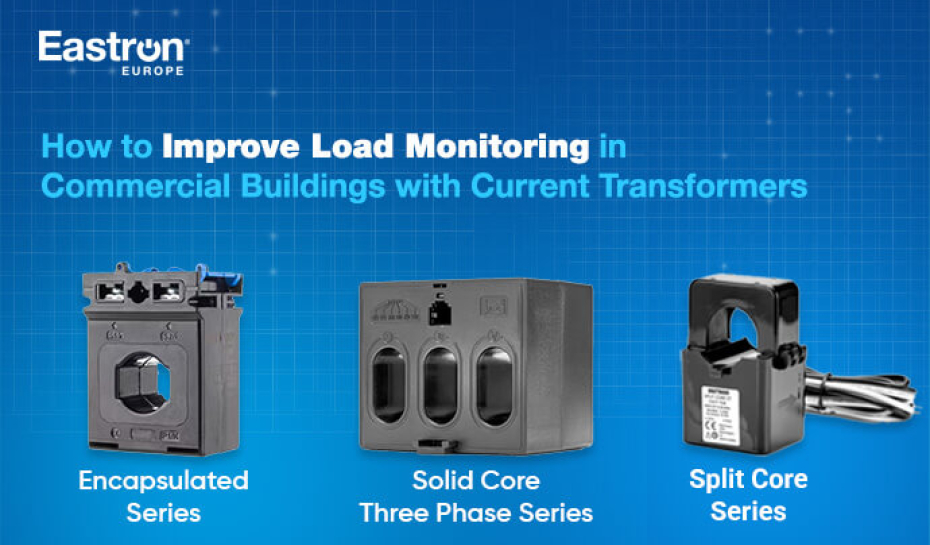
How to Improve Load Monitoring in Commercial Buildings with Current Transformers
Load monitoring effectiveness serves as the very backbone of efficient energy usage, especially in modern commercial buildings.
Office towers, retail centres, and other commercial outlets are under constant pressure to restrain volatile energy costs, improve sustainability, and ensure operational reliability. Here, current transformers (CTs) have become indispensable.
Accurate current measurements and data sharing in real-time through CTs allow granular monitoring of power consumption across various systems.
With the help of a current transformer, facility teams can readily track usage trends and identify inefficiencies, captured from air conditioning, lifts, or lighting. This is the only way to make data-driven energy decisions.
The Role of Current Transformers in Load Monitoring
The device, the current transformer, is a small device that keeps high electrical current down to a safer, measurable level for energy metering systems.
CTs, such as Eastron Europe's Encapsulated Single-Phase ECT-2 and others, are best-suited for commercial, industrial, or utility applications. Compatible with standard metering or relay products, these single/three-phase current transformers help commercial sectors with:
● Isolation of the current for safe metering
● Real-time load analysis
● Energy audits and billing
● Electric standards compliance
These transformers work seamlessly with Building Management Systems (BMS), enabling automated reporting and diagnostics to improve building efficiency.
Why Load Monitoring Matters in Commercial Sectors
The commercial sector is energy-intensive. The commercial outlets have a high energy demand, which varies significantly throughout the day. For example, HVAC systems may draw power in the early morning and late afternoon, while lighting and IT infrastructure consume energy consistently.
Without precise load monitoring, it becomes difficult for the management to keep an eye on energy usage.
Current transformers allow them to track and respond to these variables and enable a proactive energy management system for the building.
Here are some of the reasons why CTs matter:
● Detecting peak energy demand periods.
● Allocating energy costs across departments or tenants.
● Preventing circuit overloading and potential outages.
● Maintaining optimal performance of energy-saving systems.
Benefits of Eastron Europe’s Current Transformers in Commercial Sectors
Eastron Europe's current transformers are categorised under three different heads, each serving a different purpose in energy management:
● Split Core Current Transformers
● Encapsulated Transformer Series
● Solid Core Three Phase Series
A Split Core, for instance, offers unmatched flexibility, especially for retrofit or live installations.
An easy installation, minus power outage, being one of its unique benefits. Additionally, they are easily installed in tight panels and can be adjusted with older infrastructures, such as ESCT-SC Series Split Core CT.
From tracking individual circuits, monitoring branch panels, or overseeing energy use by floor or unit, the current transformers' benefits are limitless. The best part is that these devices function without downtime.
Some of the benefits of each current transformer from Eastron Europe are described below:
1. Monitoring Three-Phase Loads Efficiently
Most commercial buildings use three-phase power to run equipment and systems more efficiently.
Accurate monitoring of each phase is crucial to ensure load balancing and to avoid equipment stress or utility penalties due to power factor imbalances.
A three-phase current transformer, for instance, Eastron Europe's T24-3CT, supports detailed data capture in real-time from all three lines.
This is especially important for heavy-load areas such as:
● Commercial kitchens
● HVAC plants
● Data centres
● Industrial lifts or escalators
For complete visibility in each phase's performance, pair three-phase current transformers with Eastron Europe's SDM630 multi-function meters.
This will enhance energy diagnostics and load management.
2. Supporting Scalable Sub-Metering and Energy Efficiency
Commercial buildings often host multiple tenants or departments.
Sub-metering each space improves transparency and accountability for energy usage. With CTs, scalable sub-metering systems are readily implemented, allowing the real-time data to feed into cloud dashboards or BMS.
As stated earlier, they are suitable for billing and cost allocation and can be used in conjunction with SDM230 Modbus Meters for detailed energy tracking in individual units or systems.
This modular approach makes it easier to optimise usage, promote energy-saving habits, and prepare buildings for future energy compliance standards.
3. Simplifying Maintenance and Enhancing Safety
Another key advantage of current transformers is reduced maintenance complexity. The measuring system is isolated from the high-voltage circuit to improve system safety during inspection, calibration, or replacement. Additionally, compact CTs such as Eastron Europe ESCT-MC Series are ideal for tight electrical cabinets. They reduce installation time and support safer, faster rollouts across large commercial premises.
Conclusion
Load monitoring and management in commercial buildings begin with the right tools. Current transformers are designed for the same purpose, helping commercial property managers to unlock cost savings, enhance sustainability, and future-proof their buildings for a greener future.
